Great Dane: features of the breed and care of dogs
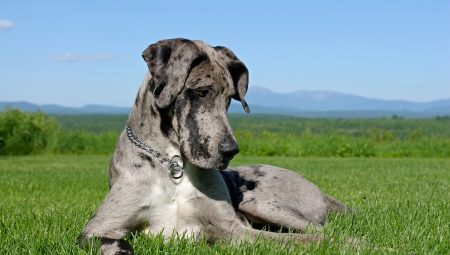
The noble giant of the canine world, who is often called the largest indoor dog in the world. Such a “domestic” nickname the Great Danes received for their friendly character, responsiveness and sincere affection for their owners and their families. In any situation, this dog is invariably restrained, majestic and looks like an elegant statue. Even when agitated and agitated, the animal never shows its anxiety.
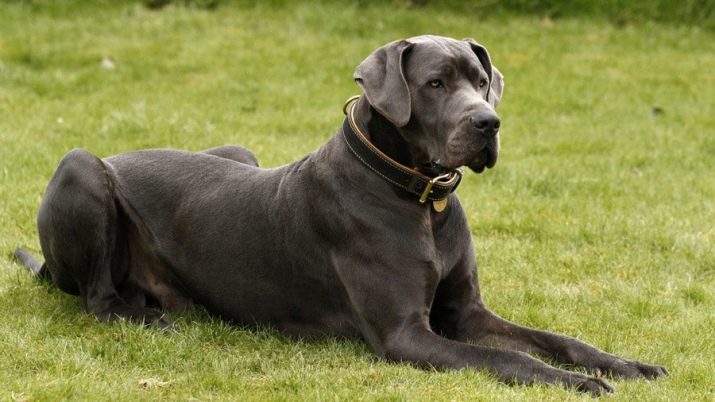
Origin story
The roots of the formation of the breed go back to ancient times. Scientists have identified several rather large dogs, which are combined under the term "mastiff". In addition to the German Great Dane itself, it included Dalmatians, St. Bernards, Rottweilers, Bulldogs, as well as Newfoundlands, Mastiffs and Leonbergers. It is believed that they all descend from a single ancestor - the giant Tibetan mastiff.
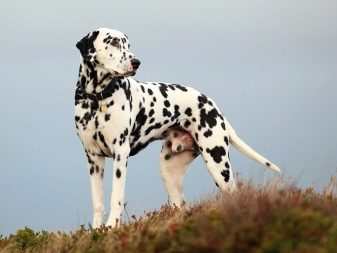

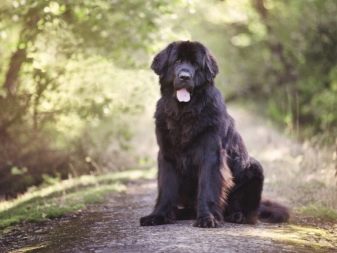
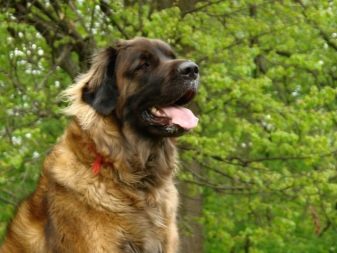
This variety was one of the very first service dogs, and the earliest evidence of this large dog dates back to the 12th century. BC NS.
Huge, hardy and physically strong dogs have been used for centuries to guard remote monasteries, as well as to protect nomadic tribes and while hunting large mammals. Gradually, the Tibetan mastiffs spread throughout the rest of Asia, appeared in Persia and India. It was there that they first began to be used as a real "combat weapon" during military battles with the enemy, which significantly increased the value of the breed.
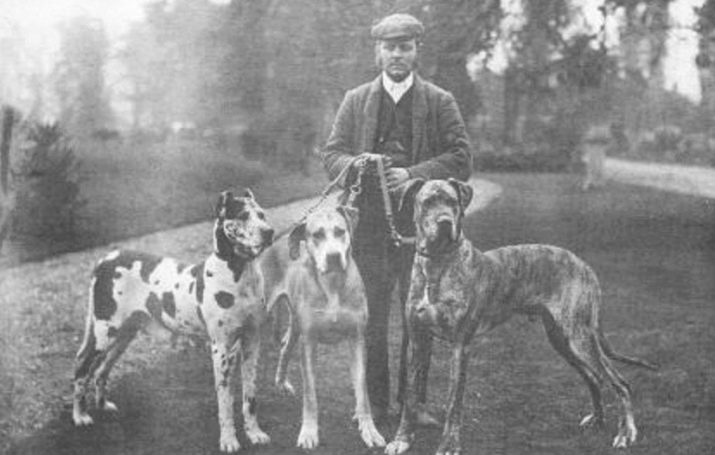
So, according to Persian laws, the murder of a Tibetan mastiff was considered an even more serious crime than the murder of a person, and threatened the culprit with a huge fine.
Excavation data indicate that dogs of this breed took an active part in numerous military-conquest campaigns of King Xerxes, were used to suppress popular riots in Egypt and Babylon. The dogs also participated in the protracted Greek campaign - this is how, as war trophies, the dogs came to the Greeks, where their qualities were very highly appreciated.
Images of Great Danes can be seen on ancient Greek coins, and a monument to these animals was even erected in the city of Corinth for exceptional merits in the battles with the Peloponnese. Tibetan Great Danes are also mentioned in the writings of Aristotle, who paid tribute to the incredible physical strength and endurance of these beautiful and noble dogs.

The fame of the dogs came to one of the greatest generals in the world - Alexander the Great, who became their ardent admirer. A little later, the Molossians (that was the name of the huge immigrants from Tibet in the countries of Europe) also attracted the attention of the ancient Romans. In peacetime, so that the animals did not lose their shape, they were forced to fight in the rings with wild animals, and during military campaigns they were obligatory accompanied by the troops.
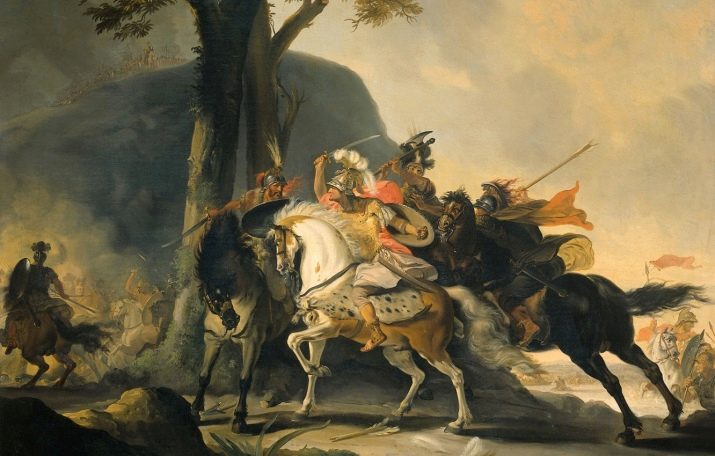
Subsequently, the dogs, together with the legionnaires, landed on British lands, and a little later in Germany, France and the Scandinavian countries.
Images of these large dogs can be found on the runestones that have survived to our times. Dogs are mentioned in the ancient Icelandic epic, and in the Museum of the History of Denmark there are even skeletons of a family of giant dogs, their remains date back to the 10th-5th centuries. v. BC NS.
Thus, over the course of several centuries, the great migration of the Great Danes took place, and by the 19th century they ended up in various countries of the Old World, where several populations were bred, differing from each other in color and constitution. But the invariable characteristic of all dogs of this type was strength and impressive size.
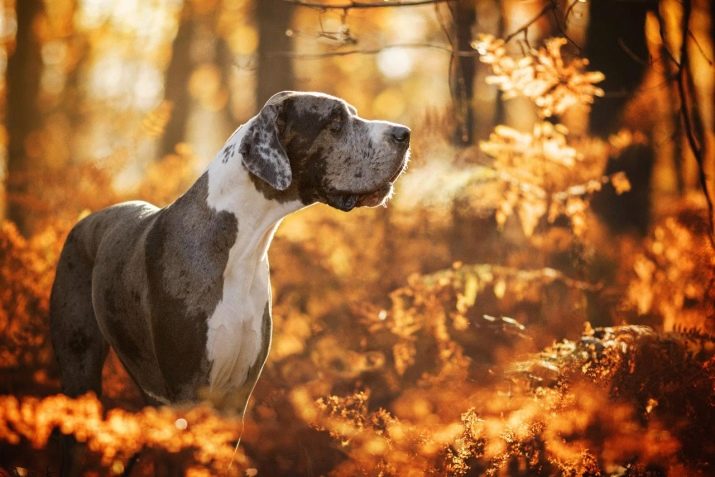
Years passed, the era of ancient military campaigns remained in the past, weapons were improved and completely different tactics gained popularity in combat battles. As a result, the need to use Great Danes in battle gradually faded away, so completely different qualities of dogs came to the fore. In those days, dogs began to be used when hunting large animals - qualities such as endurance and exceptional running ability made dogs very popular with hunters of noble birth.
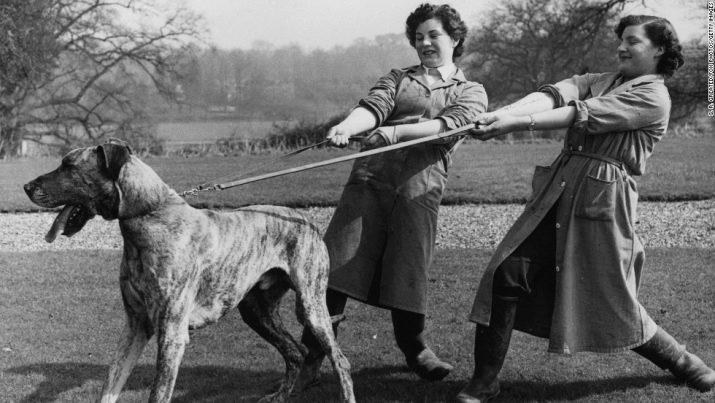
The greatest success in this field was achieved by breeders from England, who crossed Tibetan Great Danes with "boar dogs" widespread in England at that time. Thus, due to the addition of wolfhound and mastiff genes, the representatives of the new breed received rather long legs and a very graceful physique. Wild boars and hoofed animals simply did not have a single chance to withstand the attack of such athletes.
At the same time, the hunting instinct of the dog was appreciated, because European aristocrats more and more often began to have Great Danes as their personal guards.
For a long time there was a real confusion in the name of the breed. In France, dogs were called Dogue Allemand, in Germany - Englische Docke, in the British Isles - German boarhound. There were other variants of names, which meant an essentially similar type of dog, however, it is impossible to talk about one breed. For the first time, the decision to monitor the purity of the breed was made by the Danes in 1866 - it was then that the standard of the Danish mastiff was first drawn up.
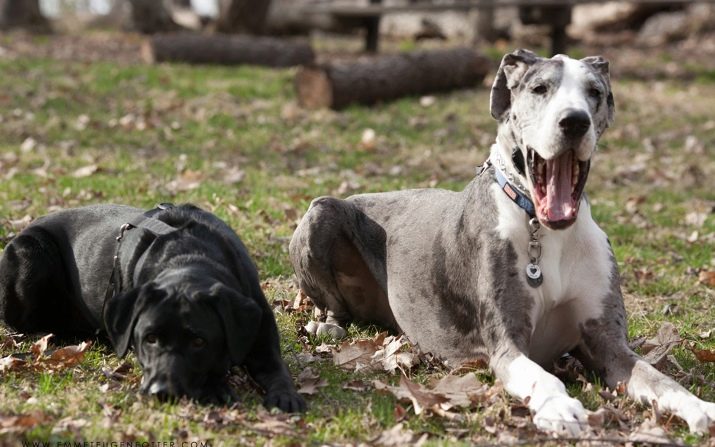
However, interest in this case faded very quickly, and nowadays only the English-language version of the sound of the breed's name, which in translation means "big Dane", speaks about it.
Only at the very end of the 19th century, dog breeders united their efforts in order to create on the basis of variegated mastiff-like dogs a single species that would embody the best features and performance characteristics of dogs from different regions and countries.The initiative group began its work in Germany in 1878, and after a couple of years a new standard was adopted. In 1888 a dog club began its activity in Berlin.

In order to preserve the purity of the breed, it was allowed to obtain offspring in strictly defined combinations, otherwise the recessive genes could cause a lightening of the dog's shade or the appearance of spots of unnecessary color. Until the outbreak of World War II, active work was carried out to maintain the breed, but during the years of the battles most of the kennels were destroyed, and the dog population itself decreased sharply. After the establishment of peace, the genotype of these animals had to be restored again.
Today the breed is officially recognized by the world's largest canine organizations.
Great Danes first came to Russia even before the October Revolution - Emperor Alexander II brought two puppies from an exhibition in Hamburg, but the breed did not gain much popularity in our country. Only at the end of the 70s of the last century in the Soviet Union, the development of the breed was taken seriously, and before that, Great Danes were mainly acquired in the countries of the former socialist camp - Poland, the GDR and Czechoslovakia.
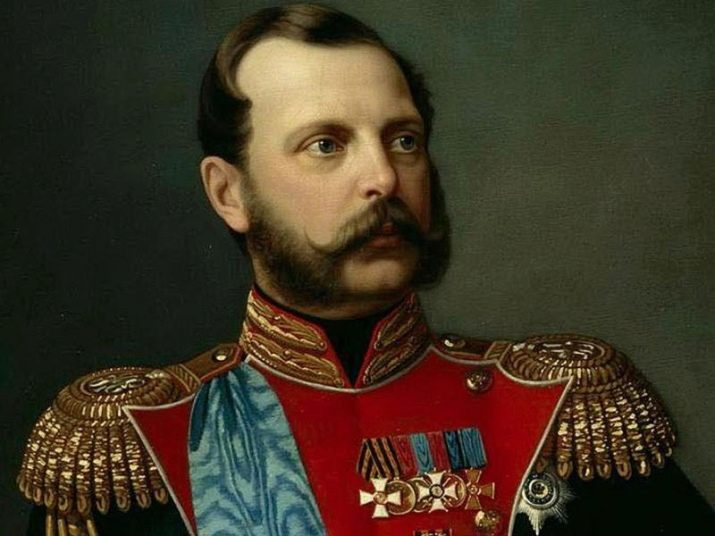
Nowadays, nurseries can be found in almost all major cities of the country.
Description
The largest Great Dane in history is considered a Great Dane named Zeus - his height at the withers is 111.8 cm. Another dog named George from the United States is no less famous, who, with a height of 109.2 cm, had a body weight of about 111 kg.

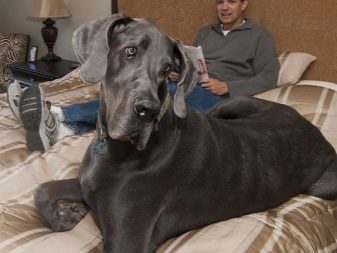
The Great Dane is one of the tallest breeds in the world. This is a very impressive-looking dog, which by its very appearance scares away everyone who wants to come closer - people are simply afraid for their health. By the way, completely in vain - Few people know that behind the formidable appearance a truly "golden soul" is hidden.
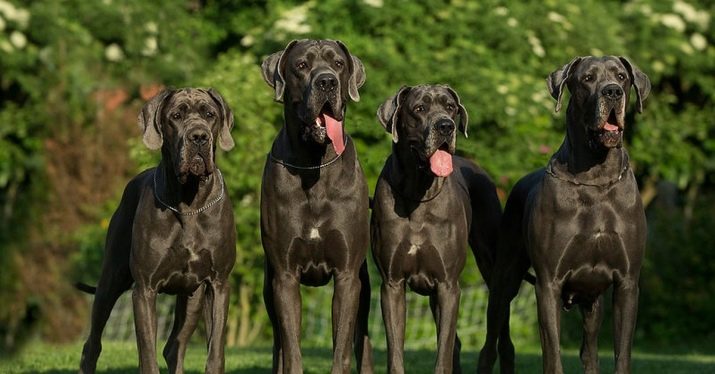
The following exterior features correspond to this noble and good-natured giant.
- The average height of females is 75 cm, for males - 85-90 cm.
- Body weight reaches 90-95 kg.
- The body of the bitch is slightly elongated, in the male it has a more square shape.
- The head is rather large, as if it had been slightly cut down on the sides. The transition line from the forehead to the nose is well defined.
- The dog has 42 teeth. Like many other dogs, a scissor bite.
- The nose is usually black in color, the only exception is marble mastiffs.
- The eyes are quite smart, lively, the iris is dark in color. In the blue varieties, discord is allowed, and in the marbled dogs, slight lightening.
- The ears are large, hanging type, high landing.
- The neck is usually vertical, slightly tilted forward at the withers when moving quickly. The musculature of the neck is pronounced, which gives it a very powerful appearance.
- In accordance with the breed standard, the back is straight, straight, but slightly bent near the tail.
- Tail length is average. During the run, the tail is slightly raised; twisting of the donut is allowed.
- Feet, both front and rear, straight, parallel, very powerful.
- The coat is short, quite close to the skin, moderate shedding.
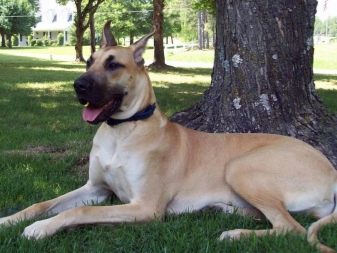
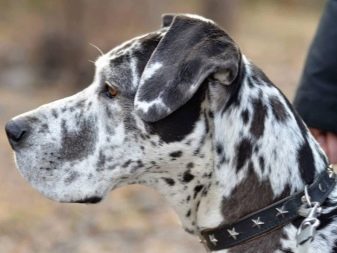
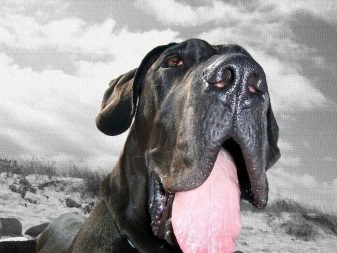
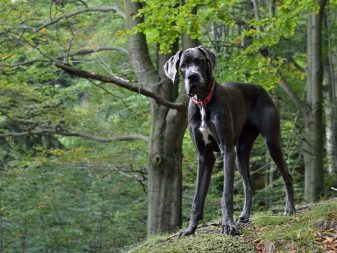
Not many people know that mastiffs grow for a rather long time - their final formation ends only by 22-24 months. This is much longer than in dogs of all other varieties.
Great Danes look great in any color, but the following suits are allowed according to the standard.
- Marble mastiff - it is more often called "harlequin". The coat of these dogs is painted in a white shade, dark specks with ragged edges are scattered all over the surface - they can be of various sizes.
- Tiger mastiffs look very impressive... They are ginger dogs with dark gray and black stripes in random order.
- Looks really impressive blue great dane... From the side of his coat, it looks more like grayish, but under certain lighting it acquires a pronounced bluish tint.
- Fawn mastiffs - these are brown dogs, similar to brindle, but without stripes.
- Great Dane black make an indelible impression - they are usually painted completely in one color, rarely have small whitish spots on the fingers or in the sternum.
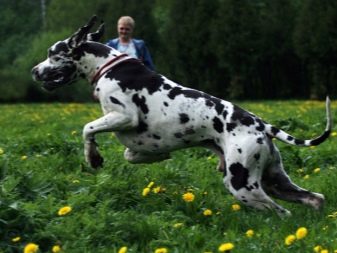
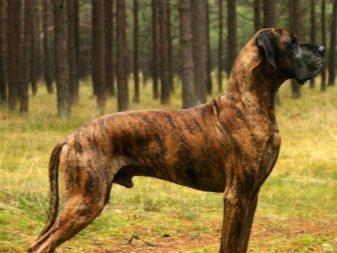



Character
Dogs gained wide popularity after the release of the animated film about Scooby-Doo and the appearance of the Marmaduke comics. But in fact, these dogs do not at all look like those cowardly narrow-minded animals that become a source of eternal troubles for their breeders. In fact, these are intelligent dogs that, despite their impressive size, remain restrained and reasonable.
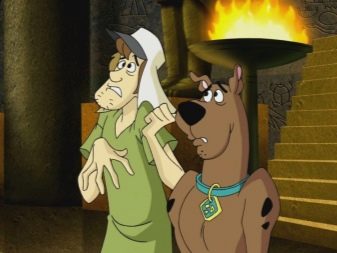
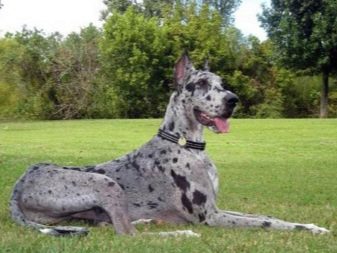
Any Great Danes breeder will surely say a lot of flattering words about his pet. These giants are naturally extremely intelligent and extremely friendly. Of course, young puppies of this breed, like all other babies, love to play, are prone to mischief, which, given their size, can be truly destructive.
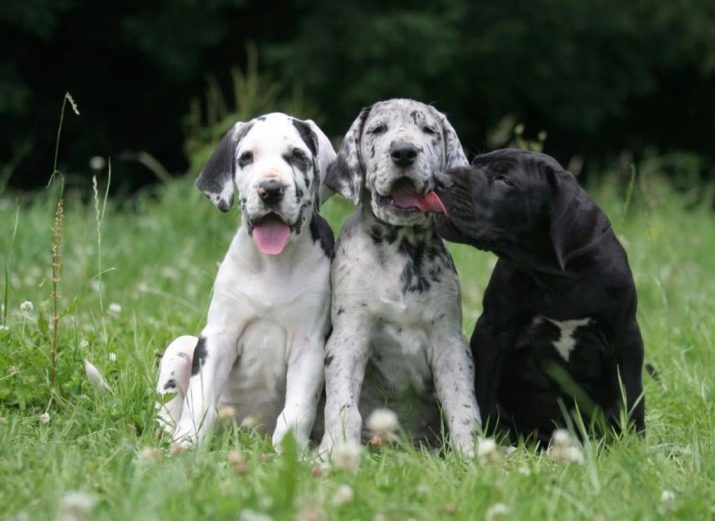
However, such a dog will never harm or do nasty things on purpose, for his own pleasure.... Therefore, if in the heat of the game you find yourself thrown to the floor, you should not take this for a manifestation of aggression. In the process of growing up, a kid still does not know how to realize his own dimensions and simply does not measure the strength that he applies in order to emerge victorious in a comic battle for a toy or stick.

As the mischief grows, the dog becomes more sedate and restrained, but remains educated and loyal. Great Danes have a very strong instinct of protector and guard, it will become an excellent guardian for weak "members of the pack". You can safely leave babies with this dog - it will be an excellent nanny for children, who will not allow anyone to offend children.
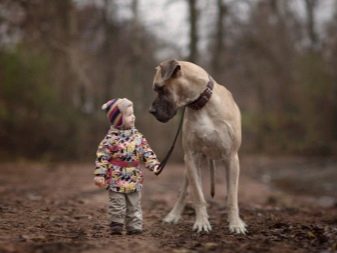
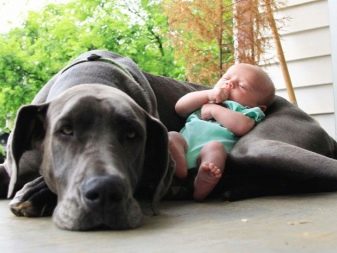
However, this does not mean that the dog cannot show character. The calm appearance of the animal should in no case mislead others - with the look with which this dog looks around what is happening around, he simply monitors the surrounding situation.

It is important for the dog to keep the situation under its control, so that in case of danger, immediately show those who encroach on the life or property of its owners, who is in charge here.
However, they never show unmotivated hostility towards ordinary passers-by. The only exceptions are mentally unhealthy animals, which in the past have become victims of illiterate upbringing or even cruel treatment by humans.
These are domestic dogs that enjoy spending time with their family. The animal is psychologically difficult to bear separation from the owner, therefore, if the professional activity of the breeder is associated with long absences, then it is worth giving preference to dogs of other breeds.
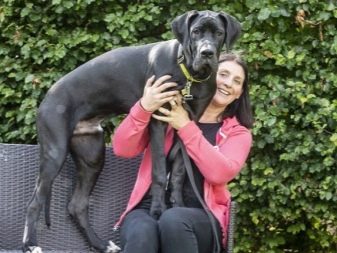
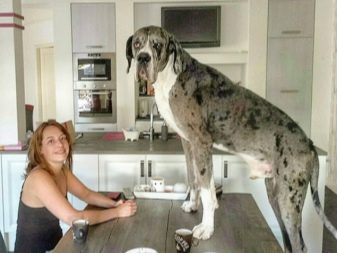
Life span
Unfortunately, these giants cannot boast of strong immunity and long life expectancy. By the age of 8-9, Great Danes are considered decrepit old people, therefore there are very few dogs older than this age.
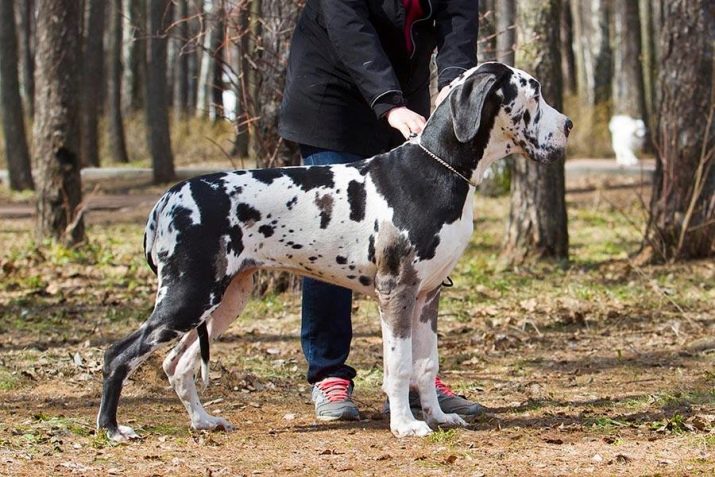
The main cause of death of Great Danes, according to statistics, is volvulus, which often occurs even in young and strong dogs. If such a problem arises, surgical intervention is required as quickly as possible, any delay is fraught with the death of the pet.
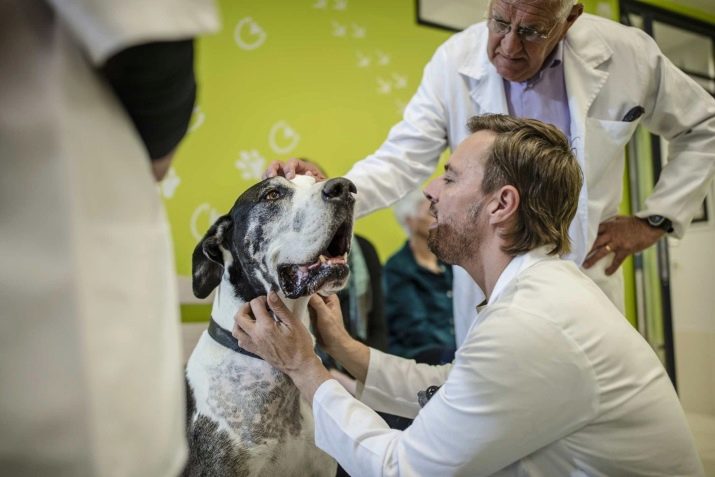
Bloating, foaming vomiting, and heavy breathing in a dog should be a reason to see your veterinarian immediately.
Great Danes are late maturing breeds, so their musculoskeletal system takes a very long time to develop. In these animals, congenital dysplasia, frequent problems with the spine are not uncommon, pathologies of the lumbar and cervical regions are especially common in older dogs. Until the dog reaches one and a half years try to avoid excessive physical exertion - exhausting jogging and tedious walking up stairs, especially down.
Young dogs are advised to bandage their metacarpals before going outside. Also, in some cases, the veterinarian may advise breeders to use special feeds with chondroprotectors - substances that contribute to the proper formation of joints.

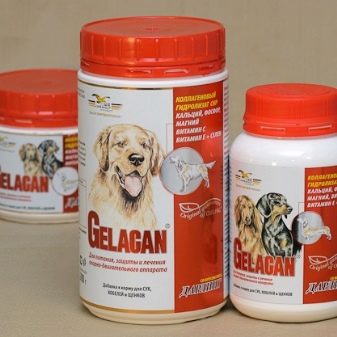
Diseases common in Great Danes include the following ailments.
- Flatulence. The abnormal structure of the stomach often leads to flatulence and heaviness in the stomach - this happens if the dog remains active after feeding. That is why it is necessary to teach the animal to rest after eating for at least half an hour.
- Helminths... Worm infestations are very dangerous for dogs, especially in Great Danes puppies. To eliminate the occurrence of such problems, already at the age of 3 weeks, antiparasitic treatment is started, and once a quarter, feces are taken for tests.
- Entropion - represents mechanical damage to the eyes by the elongated edge of the eyelid. This happens with a "raw" structure of the skull and often causes a dog to lose sight.

Certain pathologies are also genetic in nature. So, blue mastiffs often inherit weak immunity, and marbled dogs often suffer from infertility, deafness and blindness.
In order to reduce the risk of developing serious diseases, it is necessary to carry out vaccination of animals. Thanks to vaccinations, the immune system is stimulated, which can significantly reduce the risk of damage to many diseases that are dangerous for a pet. If you have a Great Dane, make up a vaccination schedule with your doctor and strictly adhere to it. The first vaccination is given to the dog at 2 months.

The huge growth of the animal often leads to pathologies of the cardiovascular system; cardiomyopathy and aortic stenosis are not uncommon for Great Danes. Also, animals suffer from kidney disease (Addison's disease), thyroid gland (hypothyroidism). Skin diseases occur: interdigital dermatitis, demodicosis, histiocytoma. Often there are pathologies of the organs of vision - cataracts and entropy of the eyelids.
In order to maintain the quality of life of a living person, maintain its activity and extend its life span, one should tirelessly monitor its condition and eating behavior - in case of any doubts, immediately contact the clinic.
Maintenance and care
The best place to keep the Great Dane will be a spacious private house, preferably with a large garden plot near the reservoir. However, in a city apartment, a pet can be quite comfortable if he is given the opportunity to throw out all the accumulated energy during long daily walks.
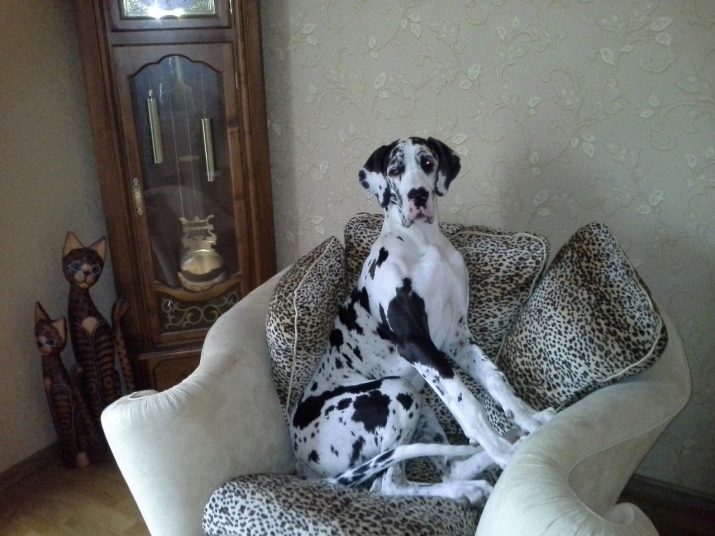
Many do not dare to have a Great Danes in an apartment because of their size, suggesting that such a dog will take up too much space. However, as evidenced by the reviews of experienced owners, Great Danes manage to be inconspicuous and compact, behave quietly and show great respect for the personal space of all family members.

A separate place should be equipped for the animal - it should be located in a separate corner, where the dog will not be kicked by household members scurrying from room to room. You should not place a bed near heating appliances, as well as in places where a draft often occurs - the wind, like excessive dry air, has the most adverse effect on dogs and leads to the development of serious diseases.
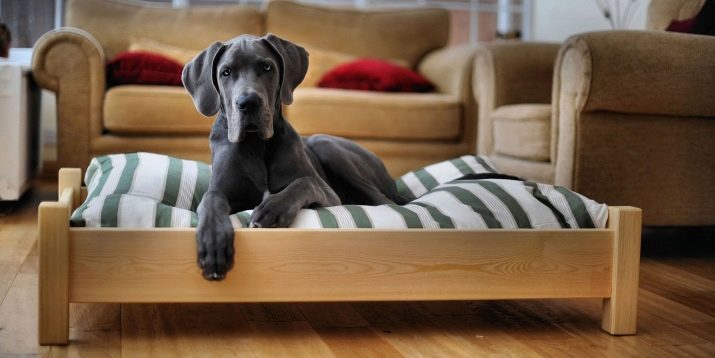
In order for the pet to be comfortable and comfortable, you need to buy a high mattress that will fit the size of the dog. If possible, try to get a special sofa for dogs, as with age, animals often have problems with the spine, and a thin mattress will not be enough for them.

Keeping an animal in a booth or aviary is strictly not allowed, especially in the cold season. The only exceptions are cases when you have built a heated house for your pet, but then the booth should be very spacious and voluminous.
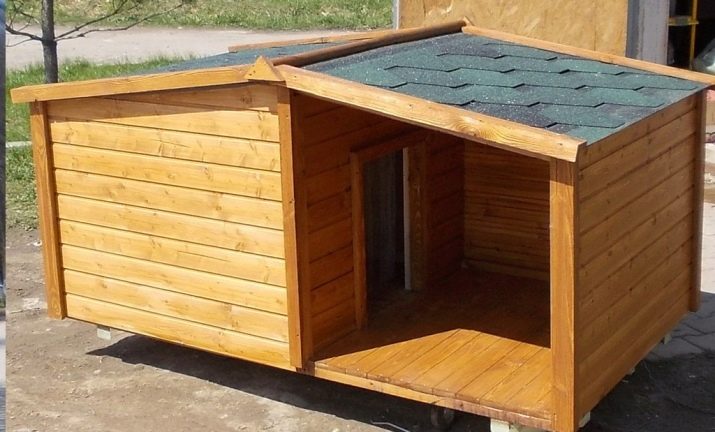
If dogs live in a private house with the possibility of round-the-clock self-walking, then this is very good for the health of the pet. But if the animal is kept in an apartment, then the need for physical activity should be satisfied by walking - the dog should be walked twice a day, for at least 1.5-2 hours.

In winter, the number and duration of walks can be reduced.
To maintain the flawless appearance of the pet, it is necessary to comb its fur with a special stiff brush once a week. Great Danes are bathed infrequently - 3-4 times a year and in case of heavy pollution.
Please be aware that the procedure is not at all simple - a dog of this size will not fit in a basin, so washing procedures will have to be carried out in the bathroom... Many breeders use groomers. If you intend to bathe the dog yourself in your own bathroom, then try to accustom your pet to these procedures from early childhood.

Every 5-7 days, the ears of the animal should be inspected for inflammation, ear sulfur secretions and injuries.... During the examination, it is necessary to treat the inner surface with a special veterinary lotion or a weak solution of boric acid.

Brush your Great Dane's teeth at least once a week. This can be done with a special paste and a brush, or you can give preference to special "long-playing" bones, which help to remove tartar in dogs.
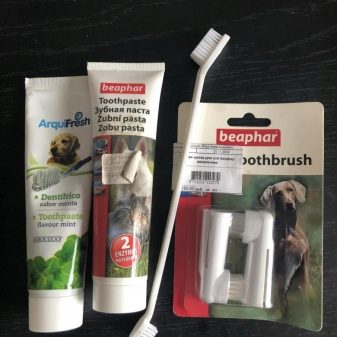
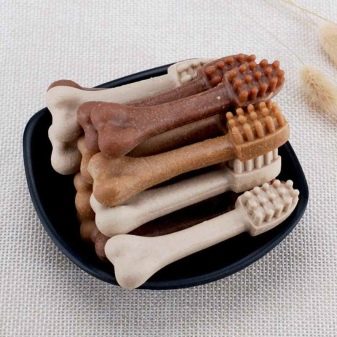
Usually, the claws of dogs grind off themselves, but if the animal walks mainly in a forest belt or on an area with soft ground, then you will have to cut them from time to time with special cutters, since they will not grind on the road surface.
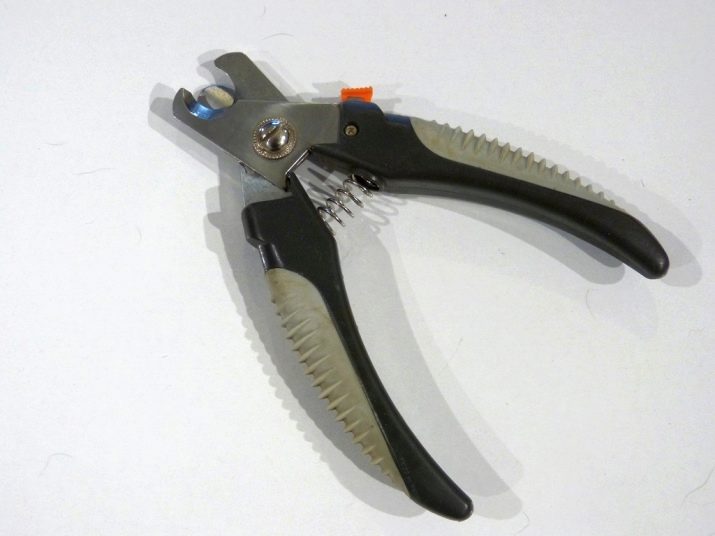
Eyes should be wiped with chamomile infusion or a weak furacilin solution a couple of times a week. Prophylactic instillation of anti-inflammatory drops every 10-14 days will not hurt either.
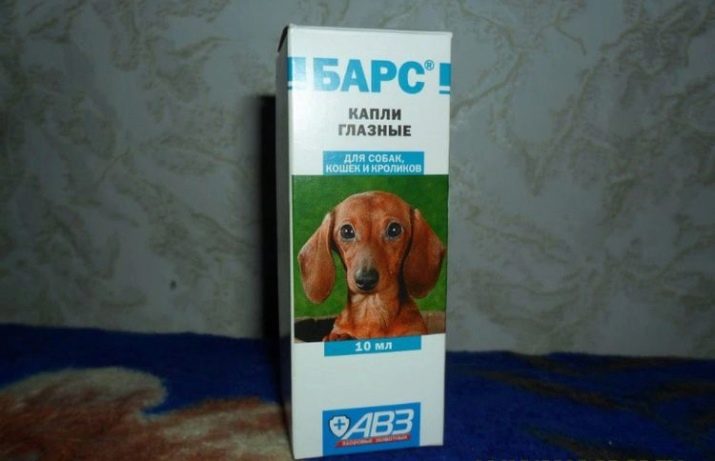
Ear cropping
The issue of ear cropping deserves special attention. In accordance with the standard adopted in Germany, for a long time the ears of the Great Danes were subject to obligatory cropping in order to reduce the risk of injury to the animal while hunting.
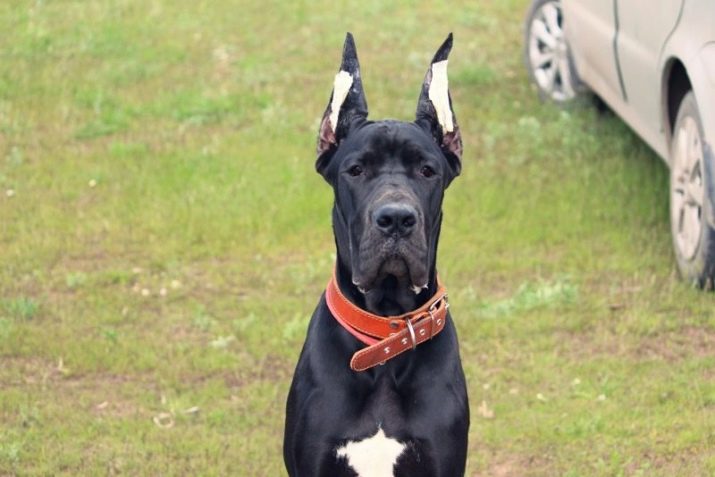
However, over time, the purpose of the dog has changed, and today mastiffs are more like guards and companion dogs, so the need for cosmetic pruning has disappeared. Moreover, since 1993, a new standard has been issued in the EU countries, which established prohibition of ear cropping - violation of this requirement is subject to a fine or other liability.
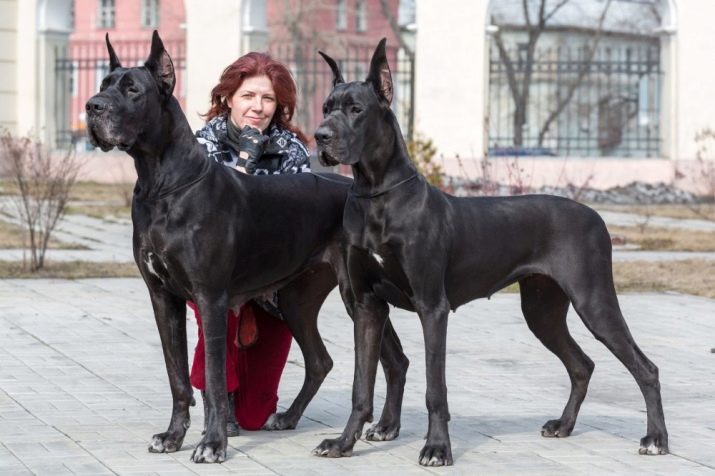
Veterinarians claim that uncropped ears are protected from dust, dirt and insects. Contrary to popular belief, they are less susceptible to otitis media - all this has led to the fact that every year the army of opponents of interference in nature is only growing.
In Russia, this issue is left to the discretion of breeders, cupping continues to be appreciated, but at the same time at exhibitions and competitions, both groups of participants compete on equal terms. In any case, the final decision on ear correction is made by the breeder after consulting a veterinarian.
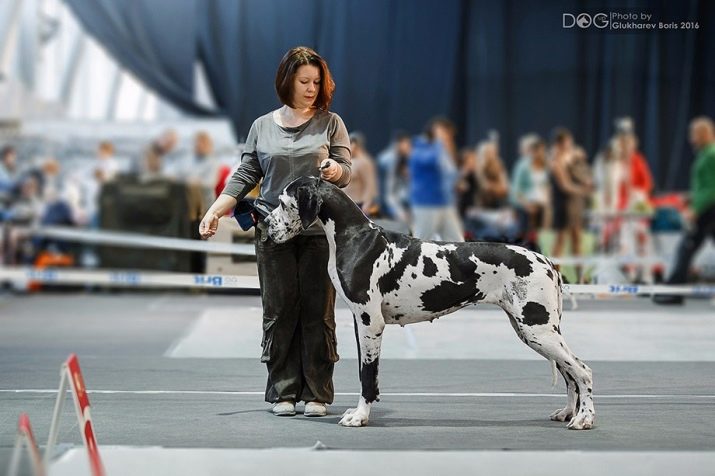
If the owner has decided to stop it, it is advisable to do this at the age of 2-3 months - at this time, the procedure is less painful for the dogs, and healing is faster.
What to feed?
Great Danes can be fed naturally or using ready-made feeds - each method has its own pros and cons. In the first case, you can always control the quality of the food offered to the dog, but this method takes time to find the ingredients for the dog porridge and prepare them. Dry food significantly saves the time of the owners, but at the same time, their composition often leaves much to be desired.
When choosing packaged feeds, it is necessary to give preference to only super-premium products or holistic products from reliable manufacturers - they use only high-quality products in their production, do not contain any preservatives, aromas and flavor enhancers.
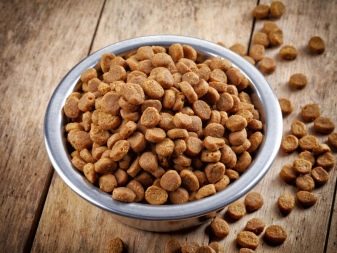

We draw your attention to the fact that, by their nature, Great Danes are not able to eat a large portion, since the gastrointestinal tract of this dog is 3 times smaller than that of its counterparts.
The grown mastiff is usually fed 2 times a day so that the morning portion is 10-15% less than the evening portion. For 1 kg of dog weight, 50 kcal is needed. The following feeding regime is optimal:
- 1.5-2 months - 6-8 times a day;
- from 3 months - 5 times a day with a parallel increase in portions;
- at 4-5 months - the animal is transferred to 4 meals a day;
- at 6 months - Great Danes switch to 3 meals a day;
- From 1 year old, dogs are fed twice a day.
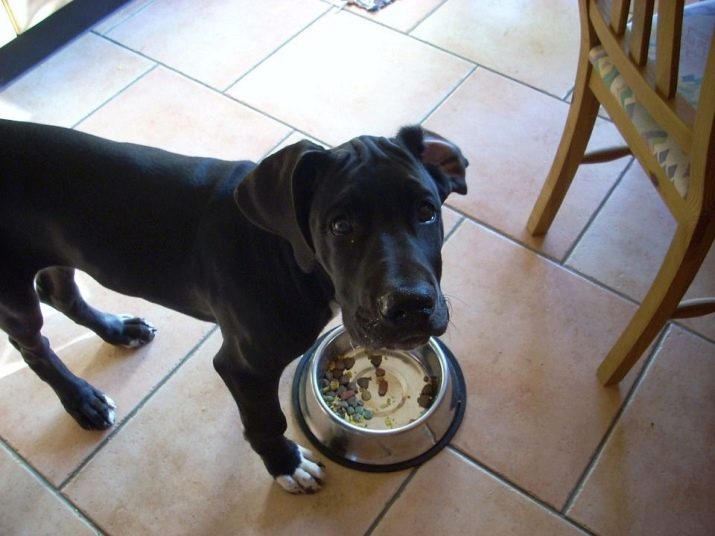
The diet of young dogs should definitely be supplemented calcium preparations, since a deficiency of this element entails an increased risk of impaired growth and development of the musculoskeletal system.
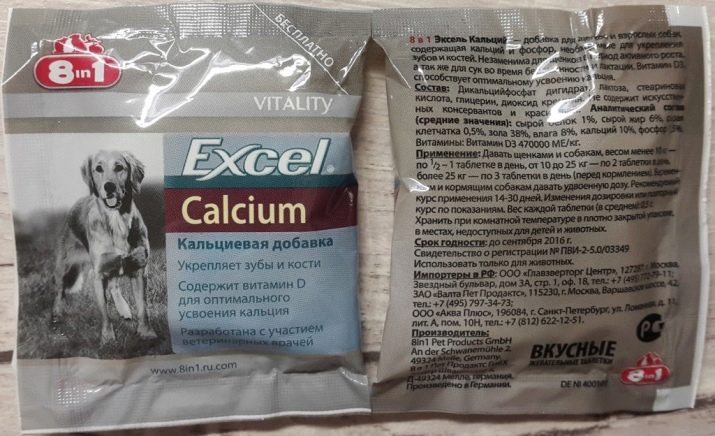
It is very important to monitor the weight of the pet - up to a year, the average daily weight gain should not exceed 150-200 grams.
If you feed your dog straight, it is best to prepare special mash for your pet. 70% of the diet should be lean meat (veal, beef, chicken and turkey), part of the meat can be replaced with high-quality offal, rich in proteins or cartilaginous collagen (heart, liver, chicken necks and heads). Also, the mash should include cereals (preferably rice or buckwheat) and vegetables - they are chopped raw or steamed.
Dogs respond best to carrots, pumpkin, squash, broccoli and cauliflower. It will not be superfluous to season the mash with chopped juicy greens, and in winter add sprouted cereal grains, rich in all the vitamins necessary for a dog.
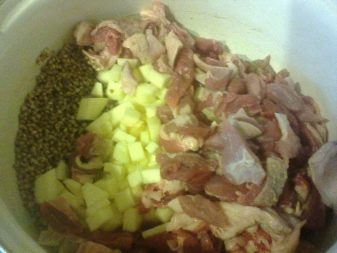
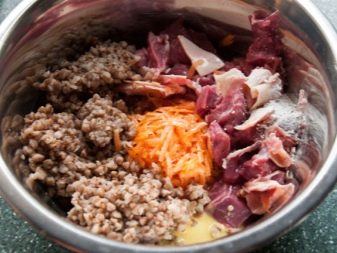
An adult dog consumes 700-800 grams of food per day. Psam of this breed is categorically contraindicated:
- fatty meat (pork);
- soybeans, corn, legumes;
- sweets of all kinds - pastries, sweets, cakes, chocolate;
- smoked meats;
- pickles and pickles;
- spicy and fried foods.
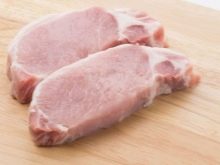


You shouldn't feed the dog from your table. Keep in mind that Great Danes have a very sensitive digestive system and any violation of the recommended dietary norms can have the most detrimental effect on the pet's health, up to volvulus.
The dog must have constant access to clean water. The contents of the bowl must be regularly renewed and the container itself must be kept clean.
Upbringing
Great Danes are very rarely trained to protect their owner - it is very difficult to cultivate aggression in this peaceful dog, and it is not necessary - for this there are a large number of other breeds of dogs. Great Danes usually require only the most general training course, which includes several blocks of training the animal:
- in place;
- to a leash, collar and muzzle;
- to a veterinary examination;
- to hygiene procedures;
- to calm reaction to loud sounds.
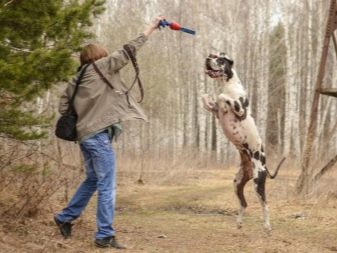

Also, in the process of training an animal, it is necessary to hone the skills of porting and study the most basic commands.
In the training of the Great Dane, it is necessary to demonstrate goodwill and patience, do not forget about the genetic characteristics of your pet - this animal always does everything "with feeling, sensibly, with arrangement." Remember to reward your dog with treats and complimentary intonations.

In conclusion, note that Great Dane is a beautiful, strong and friendly animal. Nevertheless, it is not suitable for every person. For example, it will be difficult for weak or elderly people to take care of such a large dog - the mastiff requires increased attention, you need to walk with him often and for a long time, and such a dog needs a lot of food.
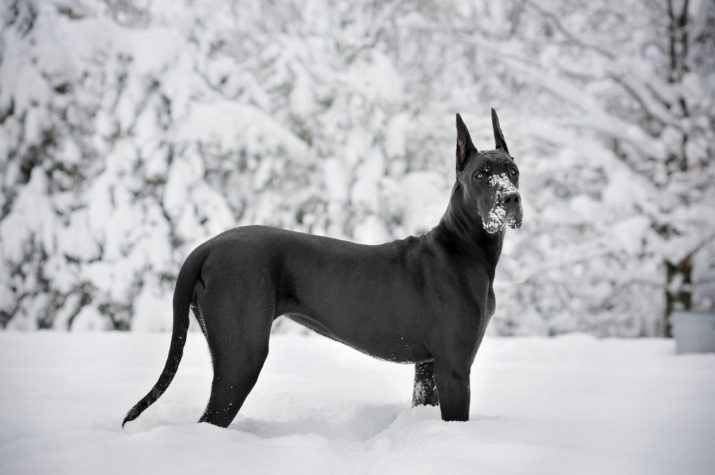
Advantages and disadvantages
Before deciding to buy a Great Dane puppy, be sure to weigh the pros and cons, evaluate your physical and material capabilities.
The pluses include the following properties characteristic of these animals:
- great companion;
- Demonstrates a friendly attitude towards children;
- easy to train;
- possesses security and watchdog characteristics;
- does not show unmotivated aggression;
- gets along with other pets;
- completely devoted to his master.
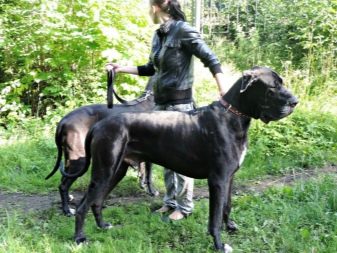
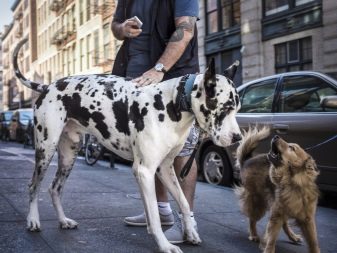
Among the disadvantages of Great Danes are:
- exactingness for walks and physical activity;
- expensive maintenance;
- very stubborn disposition;
- predisposition to obesity and hereditary diseases;
- short life expectancy;
- without proper upbringing, prone to destructiveness.
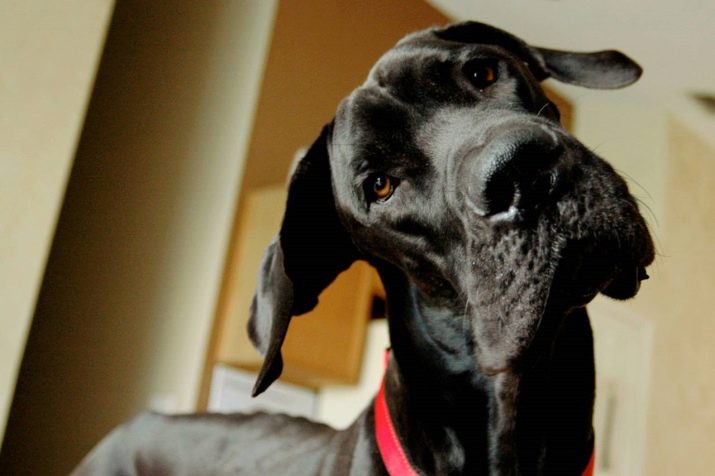
If you are determined to become the owner of the Great Dane, then keep in mind that a pet-class puppy (with breeding marriage) can be purchased for $ 300-400. Such animals cannot become a source of genetic material, and they are not allowed to participate in exhibitions, but this does not make them less friendly, loyal and hardy. Well, if you need show-class puppies, then be prepared to part with the amount of $ 1000 or more.
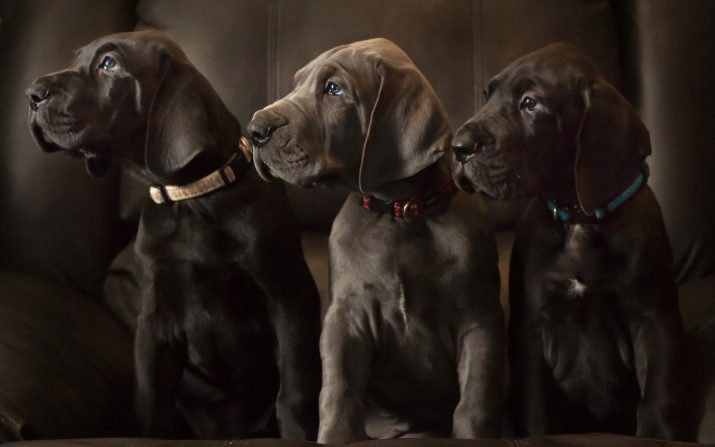
For the characteristics of the Great Dane dog breed, see below.






































